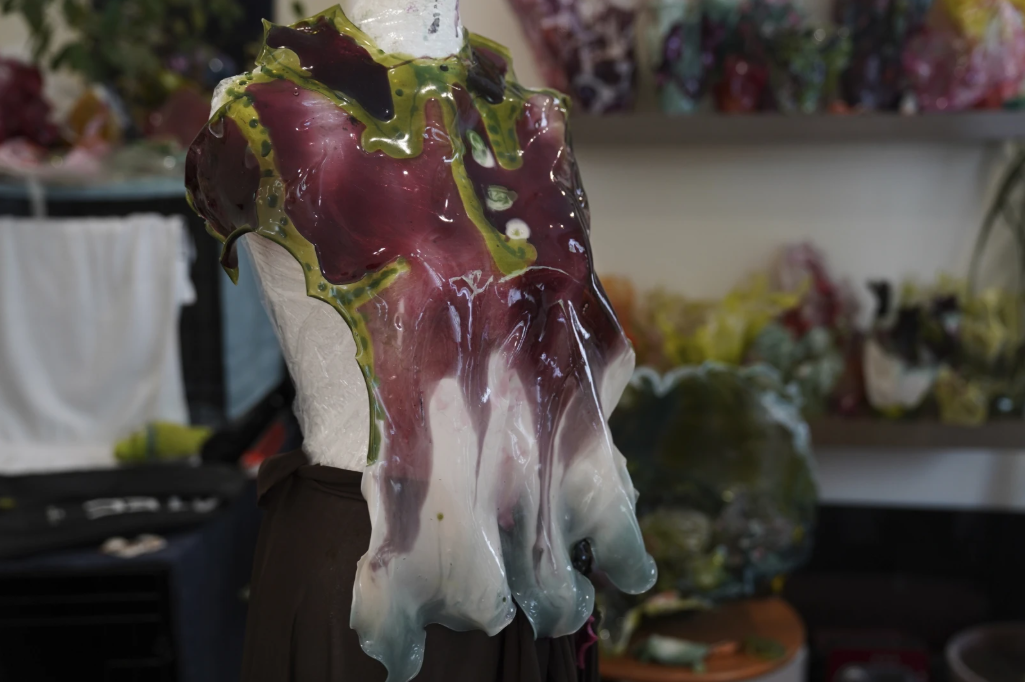
©(AP Photo/Mary Conlon)
Pre-reading questions:
I will read each question. Then, please answer them.
- What kind of clothes do you like to wear? Why?
- If you could design your own clothes, what special feature would they have?
Vocabulary:
I will read the words, meanings, and sample sentences. Then, repeat after me.
- handmade /HAND-MEYD/
- microplastic /MAHY-kroh-plas-tik/
- brand /brand/
- textile /TEKS-tahyl/
- melt /melt/
[adjective] – made by a person, not by a machine
We bought a handmade basket at the local market.
[noun] – a very small piece of plastic that pollutes the environment.
Scientists found microplastics in the ocean water.
[noun] – the name of a company that makes and sells products
That store sells many brands of mobile phones.
[noun] – a material used to make clothes or other fabric items
The museum has old textiles from different countries.
[verb] – to change from solid to liquid because of heat
The candle started to melt when the light was turned on.
Article reading:
Please read the whole article. Then, I will check your pronunciation and intonation.
A new fashion trend is focusing on reducing environmental harm by using biodegradable materials. Caroline Zimbalist, a designer from New York, is creating handmade dresses using seaweed, cornstarch, and other natural items. These dresses have been worn by celebrities and aim to show that fashion can avoid oil-based materials. Over 60% of clothes today are made from synthetic materials like polyester, which comes from fossil fuels. These fabrics produce pollution and microplastics during washing. Well-known brands like Adidas and Hermes are testing new materials such as mushroom-based textiles to find more sustainable options.
Some alternative fabrics, such as mycelium leather and corn-based cloth, are already used in luxury fashion and sportswear. However, experts say these materials are still expensive and difficult to produce in large amounts. Zimbalist’s materials, for example, can melt in high heat or smell bad if not treated properly. Even with these challenges, designers continue to work on new and creative solutions. Some experts believe these efforts could help larger companies change in the future. Companies are also studying how farming methods affect the sustainability of raw materials. Although fossil-based fabrics are still common, interest in new materials is growing. These early efforts may lead to less waste and pollution, helping the fashion industry move toward a more eco-friendly future.
Some alternative fabrics, such as mycelium leather and corn-based cloth, are already used in luxury fashion and sportswear. However, experts say these materials are still expensive and difficult to produce in large amounts. Zimbalist’s materials, for example, can melt in high heat or smell bad if not treated properly. Even with these challenges, designers continue to work on new and creative solutions. Some experts believe these efforts could help larger companies change in the future. Companies are also studying how farming methods affect the sustainability of raw materials. Although fossil-based fabrics are still common, interest in new materials is growing. These early efforts may lead to less waste and pollution, helping the fashion industry move toward a more eco-friendly future.
Comprehension questions
I will read each question. Then, please answer them based on the article.
- What is the new fashion trend trying to reduce?
- What natural materials does Zimbalist use for her dresses?
- Who has worn Zimbalist’s dresses?
- What are more than 60% of clothes today made from?
- What happens when synthetic clothes are washed?
Discussion questions
I will read each question. Then, please answer them.
- Do you think about the environment when you buy clothes? If yes, what do you try to choose? If not, what do you usually look for when shopping?
- Have you ever heard of clothes made from seaweed, mushrooms, or cornstarch before? If yes, where did you hear about them? If not, what do you think about using these materials for fashion?
- Do you agree that using natural materials in fashion is a good idea?
- What problems can happen if we use materials that melt in heat or smell bad?
- What can people do to help fashion become better for the environment?